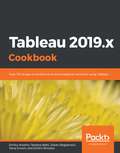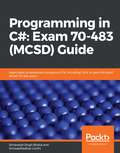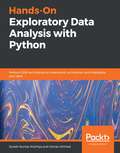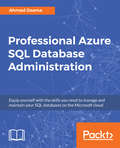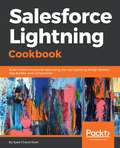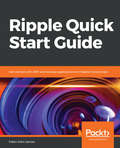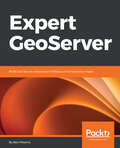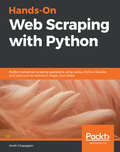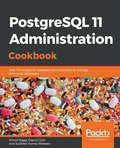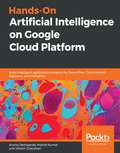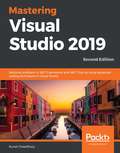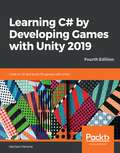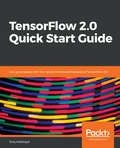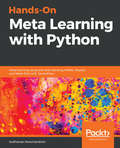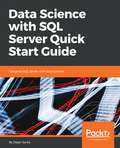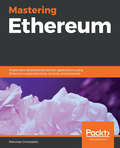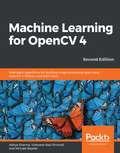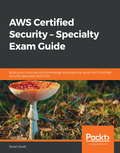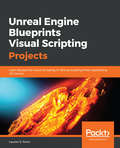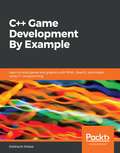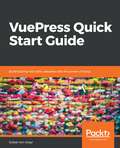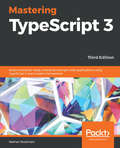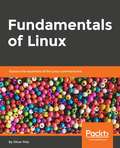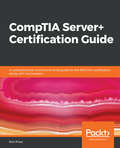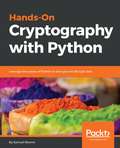- Table View
- List View
Tableau 2018.1 Cookbook: Over 115 recipes to build end-to-end analytical solutions using Tableau
by Dmitry Anoshin Teodora Matic Slaven Bogdanovic Tania Lincoln Kunal AroraThis book is for data analysts, data visualization and BI users who are looking for quick solutions to common and not-so-common problems faced while using Tableau. Put each recipe into practice by bringing the latest offerings of Tableau 2018.x to solve real-world analytics and business intelligence challenges. Some understanding of BI concepts and Tableau is required
Programming in C# (MCSD) Guide: Learn basic to advanced concepts of C#, including C# 8, to pass Microsoft MCSD 70-483 exam
by Simaranjit Singh BhallaThe book is intended to the aspirants of Microsoft certifications and C# developers wanting to become a Microsoft specialist. The book assumes C# knowledge and promises to take it to a practical level.
Hands-On Exploratory Data Analysis with Python: Perform EDA techniques to understand, summarize, and investigate your data
by Suresh Kumar Mukhiya Usman AhmedDiscover techniques to summarize the characteristics of your data using PyPlot, NumPy, SciPy, and pandas Key Features Understand the fundamental concepts of exploratory data analysis using Python Find missing values in your data and identify the correlation between different variables Practice graphical exploratory analysis techniques using Matplotlib and the Seaborn Python package Book Description Exploratory Data Analysis (EDA) is an approach to data analysis that involves the application of diverse techniques to gain insights into a dataset. This book will help you gain practical knowledge of the main pillars of EDA - data cleaning, data preparation, data exploration, and data visualization. You'll start by performing EDA using open source datasets and perform simple to advanced analyses to turn data into meaningful insights. You'll then learn various descriptive statistical techniques to describe the basic characteristics of data and progress to performing EDA on time-series data. As you advance, you'll learn how to implement EDA techniques for model development and evaluation and build predictive models to visualize results. Using Python for data analysis, you'll work with real-world datasets, understand data, summarize its characteristics, and visualize it for business intelligence. By the end of this EDA book, you'll have developed the skills required to carry out a preliminary investigation on any dataset, yield insights into data, present your results with visual aids, and build a model that correctly predicts future outcomes. What you will learn Import, clean, and explore data to perform preliminary analysis using powerful Python packages Identify and transform erroneous data using different data wrangling techniques Explore the use of multiple regression to describe non-linear relationships Discover hypothesis testing and explore techniques of time-series analysis Understand and interpret results obtained from graphical analysis Build, train, and optimize predictive models to estimate results Perform complex EDA techniques on open source datasets Who this book is for This EDA book is for anyone interested in data analysis, especially students, statisticians, data analysts, and data scientists. The practical concepts presented in this book can be applied in various disciplines to enhance decision-making processes with data analysis and synthesis. Fundamental knowledge of Python programming and statistical concepts is all you need to get started with this book.
Professional Azure SQL Database Administration: Equip yourself with the skills you need to manage and maintain your SQL databases on the Microsoft cloud
by Ahmad OsamaDiscover how you can migrate a traditional on-premise SQL server database to a cloud-based solution with Microsoft Azure. Built with database administrators in mind, this book emulates different scenarios you might come across while working with large, complex SQL database migrations and provides solutions for effectively managing the migrated databases.Key FeaturesImplement backup, restore, and recovery of Azure SQL databasesCreate shards and elastic pools to scale Azure SQL databasesAutomate common management tasks with PowerShellImplement over 40 practical activities and exercises across 24 topics to reinforce your learningBook DescriptionAs the cloud version of SQL Server, Azure SQL Database differs in key ways when it comes to management, maintenance, and administration. It’s important to know how to administer SQL Database to fully benefit from all of the features and functionality that it provides. This book addresses important aspects of an Azure SQL Database instance such as migration, backup restorations, pricing policies, security, scalability, monitoring, performance optimization, high availability, and disaster recovery. It is a complete guide for database administrators, and ideal for those who are planning to migrate from on premise SQL Server database to an Azure SQL Server database.What you will learnLearn how to provision a new database or migrate an existing on-premise solutionUnderstand how to backup, restore, secure, and scale your own Azure SQL DatabaseOptimize the performance by monitoring and tuning your cloud-based SQL instanceImplement high availability and disaster recovery procedures with SQL DatabaseDevelop a roadmap for your own scalable cloud solution with Azure SQL DatabaseWho this book is forThis book is ideal for database administrators, database developers, or application developers who are interested in developing or migrating existing applications with Azure SQL Database. Prior experience of working with an on-premise SQL Server deployment and brief knowledge of PowerShell and C# are recommended prerequisites.
Salesforce Lightning Cookbook: Build modern enterprise apps using the new Lightning Design System, App Builder, and Components
by Syed Chand ShahOver 25 recipes to help you design and test informative applications on the Salesforce Lightning platformKey FeaturesLearn Salesforce Lightning concepts from scratch.Build scalable enterprise apps with Salesforce design guidelines and the CSS frameworkUse Visualforce to build custom user interfaces for mobile and web appsBook DescriptionThe new Lightning Experience combines three major components—Lightning Design System, Lightning App Builder, and Lightning Components—to enable anyone to quickly and easily create beautiful, modern enterprise apps. If you wish to meet the challenges that Lightning throws at you head-on, then look no further because this practical book will be your faithful companion and ensure that you make best use of the Lightning platform.The book starts by walking you through the three major Lightning Components and helps you enable and configure a Lightning solution. You will explore the art of working with standard components and build a basic layout for the application. Then, you will add more advanced components using the Lightning Framework. Finally, you will also build and migrate reports and dashboards to make your app look more professional. Towards the end of the book, you’ll make use of Design System to work with Salesforce data and lay out the entire page with the components that you’ve built, before integrating Visualforce in your application.What you will learnEnable and configure a Lightning solutionCreate standard Lightning solutions and build a basic page layoutAdd custom components to your Lightning pagesBuild and migrate reports and dashboardsIntegrate Lightning pages with Visualforce to enhance performanceAdd stunning custom designs and styling with Lightning Design SystemWho this book is forThis book is ideal for Salesforce developers, admins, sales consultants, and sales managers who are comfortable with using Lightning features to build basic apps. Experience with JavaScript, CSS, and HTML would be an advantage but not compulsory.
Ripple Quick Start Guide: Get started with XRP and develop applications on Ripple's blockchain
by Febin John JamesLearn to work with XRP and build applications on Ripple's blockchain Key Features Learn to use Ripple's decentralized system for transfering digital assets globally A simpilfied and shortened learning curve to understand the Ripple innovation and Blockchain Takes a hands-on approach to work with XRP – Ripple's native currency Book Description This book starts by giving you an understanding of the basics of blockchain and the Ripple protocol. You will then get some hands-on experience of working with XRP. You will learn how to set up a Ripple wallet and see how seamlessly you can transfer money abroad. You will learn about different types of wallets through which you can store and transact XRP, along with the security precautions you need to take to keep your money safe. Since Ripple is currency agnostic, it can enable the transfer of value in USD, EUR, and any other currency. You can even transfer digital assets using Ripple. You will see how you can pay an international merchant with their own native currency and how Ripple can exchange it on the ?y. Once you understand the applications of Ripple, you will learn how to create a conditionally-held escrow using the Ripple API, and how to send and cash checks. Finally, you will also understand the common misconceptions people have about Ripple and discover the potential risks you must consider before making investment decisions. By the end of this book, you will have a solid foundation for working with Ripple's blockchain. Using it, you will be able to solve problems caused by traditional systems in your respective industry. What you will learn Understand the fundamentals of blockchain and Ripple Learn how to choose a Ripple wallet Set up a Ripple wallet to send and receive XRP Learn how to protect your XRP Understand the applications of Ripple Learn how to work with the Ripple API Learn how to build applications on check and escrow features of Ripple Who this book is for This book is for anyone interested in getting their hands on Ripple technology and learn where it can be used to gain competitive advantages in their respective fields. For most parts of the book, you need not have any pre-requisite knowledge. However, you need to have basic background of JavaScript to write an escrow.
Expert GeoServer: Build and secure advanced interfaces and interactive maps
by Ben MearnsA fast-paced guide to putting your GeoServer-based application into fast, user-friendly, and secure productionKey Features Resolve bottlenecks, optimize data stores, and cluster server resources Use identity management and authentication for a user-specific, secure web application Go beyond traditional web hosting to explore the full range of hosting options in the cloudBook DescriptionGeoServer is open source, server-side software written in Java that allows users to share and edit geospatial data. In this book, you'll start by learning how to develop a spatial analysis platform with web processing services. Then you'll see how to develop an algorithm by chaining together geospatial analysis processes, which you can share with anyone in the world. Next you'll delve into a very important technique to improve the speed of your map application—tile caching. Here, you'll understand how tile caching works, how to develop an effective tile cache-supported web service, and how to leverage tile caching in your OpenLayers web application.Further on, you'll explore important tweaks to produce a performant GeoServer-backed web mapping application. Moving on, you'll enable authentication on the frontend and backend to protect sensitive map data, and deliver sensitive data to your end user. Finally, you'll see how to put your web application into production in a secure and user-friendly way. You'll go beyond traditional web hosting to explore the full range of hosting options in the cloud, and maintain a reliable server instance.What you will learn Develop a WPS-processing service to allow web-based geospatial data processing Get to know important techniques to improve the speed of your web map application—tile caching, raster data optimization, and server clustering Find out which GeoServer settings resolve bottlenecks Develop an algorithm by chaining geospatial analysis processes together Put your application into production with hosting, monitoring, and automated backup and recovery Understand how to develop an effective tile cache-supported web service Master techniques that ensure resilient server deploymentWho this book is forThis book is for anyone who wants to learn about advanced interfaces, security, and troubleshooting techniques in GeoServer. A basic understanding of GeoServer is required
Hands-On Web Scraping with Python: Perform advanced scraping operations using various Python libraries and tools such as Selenium, Regex, and others
by Anish ChapagainCollect and scrape different complexities of data from the modern Web using the latest tools, best practices, and techniques Key Features Learn various scraping techniques using a range of Python libraries such as Scrapy and Beautiful Soup Build scrapers and crawlers to extract relevant information from the web Automate web scraping operations to bridge the accuracy gap and ease complex business needs Book Description Web scraping is an essential technique used in many organizations to scrape valuable data from web pages. This book will enable you to delve deeply into web scraping techniques and methodologies. This book will introduce you to the fundamental concepts of web scraping techniques and how they can be applied to multiple sets of web pages. We'll use powerful libraries from the Python ecosystem—such as Scrapy, lxml, pyquery, bs4, and others—to carry out web scraping operations. We will take an in-depth look at essential tasks to carry out simple to intermediate scraping operations such as identifying information from web pages, using patterns or attributes to retrieve information, and others. This book adopts a practical approach to web scraping concepts and tools, guiding you through a series of use cases and showing you how to use the best tools and techniques to efficiently scrape web pages. This book also covers the use of other popular web scraping tools, such as Selenium, Regex, and web-based APIs. By the end of this book, you will have learned how to efficiently scrape the web using different techniques with Python and other popular tools. What you will learn Analyze data and Information from web pages Learn how to use browser-based developer tools from the scraping perspective Use XPath and CSS selectors to identify and explore markup elements Learn to handle and manage cookies Explore advanced concepts in handling HTML forms and processing logins Optimize web securities, data storage, and API use to scrape data Use Regex with Python to extract data Deal with complex web entities by using Selenium to find and extract data Who this book is for This book is for Python programmers, data analysts, web scraping newbies, and anyone who wants to learn how to perform web scraping from scratch. If you want to begin your journey in applying web scraping techniques to a range of web pages, then this book is what you need! A working knowledge of the Python programming language is expected.
PostgreSQL 11 Administration Cookbook: Over 175 recipes for database administrators to manage enterprise databases
by Simon Riggs Gianni Ciolli Sudheer Kumar MeesalaA practical guide to administer, monitor and replicate your PostgreSQL 11 databaseKey FeaturesStudy and apply the newly introduced features in PostgreSQL 11Tackle any problem in PostgreSQL 11 administration and managementCatch up on expert techniques for monitoring, fine-tuning, and securing your databaseBook DescriptionPostgreSQL is a powerful, open source database management system with an enviable reputation for high performance and stability. With many new features in its arsenal, PostgreSQL 11 allows you to scale up your PostgreSQL infrastructure. This book takes a step-by-step, recipe-based approach to effective PostgreSQL administration.The book will introduce you to new features such as logical replication, native table partitioning, additional query parallelism, and much more to help you to understand and control, crash recovery and plan backups. You will learn how to tackle a variety of problems and pain points for any database administrator such as creating tables, managing views, improving performance, and securing your database. As you make steady progress, the book will draw attention to important topics such as monitoring roles, backup, and recovery of your PostgreSQL 11 database to help you understand roles and produce a summary of log files, ensuring high availability, concurrency, and replication.By the end of this book, you will have the necessary knowledge to manage your PostgreSQL 11 database efficiently.What you will learnTroubleshoot open source PostgreSQL version 11 on various platformsDeploy best practices for planning and designing live databasesSelect and implement robust backup and recovery techniques in PostgreSQL 11Use pgAdmin or OmniDB to perform database administrator (DBA) tasksAdopt efficient replication and high availability techniques in PostgreSQLImprove the performance of your PostgreSQL solutionWho this book is forThis book is designed for database administrators, data architects, database developers, or anyone with an interest in planning and running live production databases using PostgreSQL 11. It is also ideal if you’re looking for hands-on solutions to any problem associated with PostgreSQL 11 administration. Some experience with handling PostgreSQL databases will be beneficial
Hands-On Artificial Intelligence on Google Cloud Platform: Build intelligent applications powered by TensorFlow, Cloud AutoML, BigQuery, and Dialogflow
by Anand Deshpande Manish Kumar Vikram ChaudhariDevelop robust AI applications with TensorFlow, Cloud AutoML, TPUs, and other GCP services Key Features Focus on AI model development and deployment in GCP without worrying about infrastructure Manage feature processing, data storage, and trained models using Google Cloud Dataflow Access key frameworks such as TensorFlow and Cloud AutoML to run your deep learning models Book Description With a wide range of exciting tools and libraries such as Google BigQuery, Google Cloud Dataflow, and Google Cloud Dataproc, Google Cloud Platform (GCP) enables efficient big data processing and the development of smart AI models on the cloud. This GCP book will guide you in using these tools to build your AI-powered applications with ease and managing thousands of AI implementations on the cloud to help save you time. Starting with a brief overview of Cloud AI and GCP features, you'll learn how to deal with large volumes of data using auto-scaling features. You'll then implement Cloud AutoML to demonstrate the use of streaming components for performing data analytics and understand how Dialogflow can be used to create a conversational interface. As you advance, you'll be able to scale out and speed up AI and predictive applications using TensorFlow. You'll also leverage GCP to train and optimize deep learning models, run machine learning algorithms, and perform complex GPU computations using TPUs. Finally, you'll build and deploy AI applications to production with the help of an end-to-end use case. By the end of this book, you'll have learned how to design and run experiments and be able to discover innovative solutions without worrying about infrastructure, resources, and computing power. What you will learn Understand the basics of cloud computing and explore GCP components Work with the data ingestion and preprocessing techniques in GCP for machine learning Implement machine learning algorithms with Google Cloud AutoML Optimize TensorFlow machine learning with Google Cloud TPUs Get to grips with operationalizing AI on GCP Build an end-to-end machine learning pipeline using Cloud Storage, Cloud Dataflow, and Cloud Datalab Build models from petabytes of structured and semi-structured data using BigQuery ML Who this book is for If you're an artificial intelligence developer, data scientist, machine learning engineer, or deep learning engineer looking to build and deploy smart applications on Google Cloud Platform, you'll find this book useful. A fundamental understanding of basic data processing and machine learning concepts is necessary. Though not mandatory, familiarity with Google Cloud Platform will help you make the most of this book.
Mastering Visual Studio 2019 - Second Edition
by Kunal ChowdhuryMicrosoft .NET Developers who would like to learn the new features of Visual Studio 2019, and would like to delve into newer areas such as cloud computing, .NET Core, TypeScript, along with mastering the skills of building, debugging and unit testing professional apps, would benefit from this book. Basic knowledge of Visual Studio, .NET and C# is assumed.
Learning C# by Developing Games with Unity 2019: Code in C# and build 3D games with Unity, 4th Edition
by Harrison FerroneUnderstand the fundamentals of C# programming and get started with coding from ground up in an engaging and practical manner Key Features Beginner's guide to getting started with software development concepts from a macro level Leverage the power of the latest C# in solving the complex programming problems Learn to script and customize your 3D games and implement animation techniques to make them engaging Book Description Learning to program in today's technical landscape can be a daunting task, especially when faced with the sheer number of languages you have to choose from. Luckily, Learning C# with Unity 2019 removes the guesswork and starts you off on the path to becoming a confident, and competent, programmer using game development with Unity. You'll start off small by learning the building blocks of programming, from variables, methods, and conditional statements to classes and object-oriented systems. After you have the basics under your belt you'll explore the Unity interface, creating C# scripts, and translating your newfound knowledge into simple game mechanics. Throughout this journey, you'll get hands-on experience with programming best practices and macro-level topics such as manager classes and flexible application architecture. By the end of the book, you'll be familiar with intermediate C# topics like generics, delegates, and events, setting you up to take on projects of your own. What you will learn Understand programming fundamentals with practice examples in C# Explore the interface and features of Unity 2019 Learn C# programming syntax from scratch Create a game design document and prototype level Explore intermediate programming topics and best practices Implement game mechanics, interactions, and UI elements with C# Who this book is for The book caters to developers and programmers who want to get started with C# programming in a fun and engaging manner. Anyone who wants to build games and script in C# language and Unity can take this book up. No prior programming or Unity experience is required.
TensorFlow 2.0 Quick Start Guide: Get up to speed with the newly introduced features of TensorFlow 2.0
by Tony HoldroydPerform supervised and unsupervised machine learning and learn advanced techniques such as training neural networks. Key Features Train your own models for effective prediction, using high-level Keras API Perform supervised and unsupervised machine learning and learn advanced techniques such as training neural networks Get acquainted with some new practices introduced in TensorFlow 2.0 Alpha Book Description TensorFlow is one of the most popular machine learning frameworks in Python. With this book, you will improve your knowledge of some of the latest TensorFlow features and will be able to perform supervised and unsupervised machine learning and also train neural networks. After giving you an overview of what's new in TensorFlow 2.0 Alpha, the book moves on to setting up your machine learning environment using the TensorFlow library. You will perform popular supervised machine learning tasks using techniques such as linear regression, logistic regression, and clustering. You will get familiar with unsupervised learning for autoencoder applications. The book will also show you how to train effective neural networks using straightforward examples in a variety of different domains. By the end of the book, you will have been exposed to a large variety of machine learning and neural network TensorFlow techniques. What you will learn Use tf.Keras for fast prototyping, building, and training deep learning neural network models Easily convert your TensorFlow 1.12 applications to TensorFlow 2.0-compatible files Use TensorFlow to tackle traditional supervised and unsupervised machine learning applications Understand image recognition techniques using TensorFlow Perform neural style transfer for image hybridization using a neural network Code a recurrent neural network in TensorFlow to perform text-style generation Who this book is for Data scientists, machine learning developers, and deep learning enthusiasts looking to quickly get started with TensorFlow 2 will find this book useful. Some Python programming experience with version 3.6 or later, along with a familiarity with Jupyter notebooks will be an added advantage. Exposure to machine learning and neural network techniques would also be helpful.
Hands-On Meta Learning with Python
by Sudharsan RavichandiranThe book will help machine learning enthusiasts, AI researchers, and data scientists who want to learn meta learning as an advanced approach for training the machine learning models. The book assumes a working knowledge of Machine learning concepts and sound knowledge of Python programming
Data Science with SQL Server Quick Start Guide: Integrate SQL Server with data science
by Dejan SarkaGet unique insights from your data by combining the power of SQL Server, R and PythonKey FeaturesUse the features of SQL Server 2017 to implement the data science project life cycleLeverage the power of R and Python to design and develop efficient data modelsfind unique insights from your data with powerful techniques for data preprocessing and analysisBook DescriptionSQL Server only started to fully support data science with its two most recent editions. If you are a professional from both worlds, SQL Server and data science, and interested in using SQL Server and Machine Learning (ML) Services for your projects, then this is the ideal book for you.This book is the ideal introduction to data science with Microsoft SQL Server and In-Database ML Services. It covers all stages of a data science project, from businessand data understanding,through data overview, data preparation, modeling and using algorithms, model evaluation, and deployment.You will learn to use the engines and languages that come with SQL Server, including ML Services with R and Python languages and Transact-SQL. You will also learn how to choose which algorithm to use for which task, and learn the working of each algorithm.What you will learnUse the popular programming languages,T-SQL, R, and Python, for data scienceUnderstand your data with queries and introductory statisticsCreate and enhance the datasets for MLVisualize and analyze data using basic and advanced graphsExplore ML using unsupervised and supervised modelsDeploy models in SQL Server and perform predictionsWho this book is forSQL Server professionals who want to start with data science, and data scientists who would like to start using SQL Server in their projects will find this book to be useful. Prior exposure to SQL Server will be helpful.
Mastering Ethereum: Implement advanced blockchain applications using Ethereum-supported tools, services, and protocols
by Merunas GrincalaitisAn expert guide to implementing fast, secure, and scalable decentralized applications that work with thousands of users in real timeKey FeaturesImplement advanced features of the Ethereum network to build powerful decentralized applicationsBuild smart contracts on different domains using the programming techniques of Solidity and VyperExplore the architecture of Ethereum network to understand advanced use cases of blockchain development Book DescriptionEthereum is one of the commonly used platforms for building blockchain applications. It's a decentralized platform for applications that can run exactly as programmed without being affected by fraud, censorship, or third-party interference.This book will give you a deep understanding of how blockchain works so that you can discover the entire ecosystem, core components, and its implementations. You will get started by understanding how to configure and work with various Ethereum protocols for developing dApps. Next, you will learn to code and create powerful smart contracts that scale with Solidity and Vyper. You will then explore the building blocks of the dApps architecture, and gain insights on how to create your own dApp through a variety of real-world examples. The book will even guide you on how to deploy your dApps on multiple Ethereum instances with the required best practices and techniques. The next few chapters will delve into advanced topics such as, building advanced smart contracts and multi-page frontends using Ethereum blockchain. You will also focus on implementing machine learning techniques to build decentralized autonomous applications, in addition to covering several use cases across a variety of domains such as, social media and e-commerce. By the end of this book, you will have the expertise you need to build decentralized autonomous applications confidently. What you will learnApply scalability solutions on dApps with Plasma and state channelsUnderstand the important metrics of blockchain for analyzing and determining its stateDevelop a decentralized web application using React.js and Node.jsCreate oracles with Node.js to provide external data to smart contractsGet to grips with using Etherscan and block explorers for various transactionsExplore web3.js, Solidity, and Vyper for dApps communicationDeploy apps with multiple Ethereum instances including TestRPC, private chain, test chain, and mainnetWho this book is forThis book is for anyone who wants to build fast, highly secure, and transactional decentralized applications. If you are an Ethereum developer looking to perfect your existing skills in building powerful blockchain applications, then this book is for you. Basic knowledge of Ethereum and blockchain is necessary to understand the concepts covered in this book.
Machine Learning for OpenCV 4: Intelligent algorithms for building image processing apps using OpenCV 4, Python, and scikit-learn, 2nd Edition
by Michael Beyeler Aditya Sharma Vishwesh Ravi ShrimaliA practical guide to understanding the core machine learning and deep learning algorithms, and implementing them to create intelligent image processing systems using OpenCV 4 Key Features Gain insights into machine learning algorithms, and implement them using OpenCV 4 and scikit-learn Get up to speed with Intel OpenVINO and its integration with OpenCV 4 Implement high-performance machine learning models with helpful tips and best practices Book Description OpenCV is an opensource library for building computer vision apps. The latest release, OpenCV 4, offers a plethora of features and platform improvements that are covered comprehensively in this up-to-date second edition. You'll start by understanding the new features and setting up OpenCV 4 to build your computer vision applications. You will explore the fundamentals of machine learning and even learn to design different algorithms that can be used for image processing. Gradually, the book will take you through supervised and unsupervised machine learning. You will gain hands-on experience using scikit-learn in Python for a variety of machine learning applications. Later chapters will focus on different machine learning algorithms, such as a decision tree, support vector machines (SVM), and Bayesian learning, and how they can be used for object detection computer vision operations. You will then delve into deep learning and ensemble learning, and discover their real-world applications, such as handwritten digit classification and gesture recognition. Finally, you'll get to grips with the latest Intel OpenVINO for building an image processing system. By the end of this book, you will have developed the skills you need to use machine learning for building intelligent computer vision applications with OpenCV 4. What you will learn Understand the core machine learning concepts for image processing Explore the theory behind machine learning and deep learning algorithm design Discover effective techniques to train your deep learning models Evaluate machine learning models to improve the performance of your models Integrate algorithms such as support vector machines and Bayes classifier in your computer vision applications Use OpenVINO with OpenCV 4 to speed up model inference Who this book is for This book is for Computer Vision professionals, machine learning developers, or anyone who wants to learn machine learning algorithms and implement them using OpenCV 4. If you want to build real-world Computer Vision and image processing applications powered by machine learning, then this book is for you. Working knowledge of Python programming is required to get the most out of this book.
AWS Certified Security - Specialty Exam Guide: All You Need To Know To Clear The Aws Security Speciality Exam
by Stuart ScottIf you are a system administrator, or a security professional interested in getting certified with an advanced Cloud security certification then this book is for you. Prior experience in securing Cloud environments would be necessary. You need to be an Associate or Cloud Practitioner certified to take this exam.
Unreal Engine Blueprints Visual Scripting Projects: Learn Blueprints Visual Scripting in UE4 by building three captivating 3D Games
by Lauren S. FerroDesign and Develop feature-rich professional 3D games using Visual Scripting System in Unreal Engine 4Key FeaturesCreate exhilarating and interactive 3D games with Unreal Engine 4 BlueprintsTake your game designs from inspiration to a fully playable game without writing a single line of codeLearn to use visual scripting to develop gameplay mechanics, UI, visual effects, AI, and moreBook DescriptionThe Blueprints Visual Scripting system helps you to create gameplay elements from within Unreal Engine. This book will provide you with the essential foundation to learn how to build complex game mechanics quickly and easily without writing any code.Starting off with the basic setup of fundamental game components, you will gradually move on to build your first minimalistic 3D platformer game that will introduce creating basic movement along with a simple quest system. You will create a survival maze game and learn all about adding additional features to the game, such as audio, special effects, and AI, using Blueprints. Finally, you will learn how to build a multiplayer game that is playable over a network with other players. By the end of this book, you will have completed three awesome projects and be equipped with the knowledge and skills to create complex games with AI, amazing interfaces, immersive environments, and exciting multiplayer experiences.What you will learnSet up Unreal Engine and all of its foundational componentsAdd basic movement to game objects and create collision mechanismDesign and implement interfaces to extend player interactionCreate a dynamically filling inventory system along with a UI to interact with itAdd audio effects based on triggered events to various parts of the game environmentUse analytic information to tune their game valuesCreate complex enemy AI that can sense the world around it in a multiplayer gameDeploy your game to multiple platforms and share it with the worldWho this book is forIf you are new to game development or just staring out with Unreal Engine 4's Blueprint Visual Scripting system, then this book is for you. No prior game design or development experience is required. Basic knowledge of the Unreal Engine is preferred but not essential.
C++ Game Development By Example: Learn to build games and graphics with SFML, OpenGL, and Vulkan using C++ programming
by Siddharth ShekarExplore modern game programming and rendering techniques to build games using C++ programming language and its popular librariesKey FeaturesLearn how you can build basic 2D and complex 3D games with C++Understand shadows, texturing, lighting, and rendering in 3D game development using OpenGLUncover modern graphics programming techniques and GPU compute methods using the Vulkan APIBook DescriptionAlthough numerous languages are currently being used to develop games, C++ remains the standard for fabricating expert libraries and tool chains for game development. This book introduces you to the world of game development with C++.C++ Game Development By Example starts by touching upon the basic concepts of math, programming, and computer graphics and creating a simple side-scrolling action 2D game. You'll build a solid foundation by studying basic game concepts such as creating game loops, rendering 2D game scenes using SFML, 2D sprite creation and animation, and collision detection. The book will help you advance to creating a 3D physics puzzle game using modern OpenGL and the Bullet physics engine. You'll understand the graphics pipeline, which entails creating 3D objects using vertex and index buffers and rendering them to the scene using vertex and fragment shaders. Finally, you'll create a basic project using the Vulkan library that'll help you get to grips with creating swap chains, image views, render passes, and frame buffers for building high-performance graphics in your games.By the end of this book, you’ll be ready with 3 compelling projects created with SFML, the Vulkan API, and OpenGL, and you'll be able take your game and graphics programming skills to the next level.What you will learnUnderstand shaders and how to write a basic vertex and fragment shaderBuild a Visual Studio project and add SFML to itDiscover how to create sprite animations and a game character classAdd sound effects and background music to your gameGrasp how to integrate Vulkan into Visual StudioCreate shaders and convert them to the SPIR-V binary formatWho this book is forIf you’re a developer keen to learn game development with C++ or get up to date with game development, this book is for you. Some knowledge of C++ programming is assumed.
VuePress Quick Start Guide: Build blazing-fast static websites with the power of Vue.js
by Sufyan Bin UzayrA fast paced that will teach you to build Static JavaScript Sites and Amazing Web Apps Using VuePressKey FeaturesBuild quick, SEO-friendly static websites with VuePress and Vue.jsDevelop and maintain your sites long termUse the power of Vue + webpack, and develop custom themes with VueBook DescriptionWhat are static site generators, why do you need them, and how are they better than general blogging or writing or content tools? This book answers all those questions as you learn how to build sites with VuePress. This book teaches you how to build static sites in VuePress in no time. All the site content is rendered as HTML by VuePress and is then executed as a single-page web app. This means everything works fast and loads quickly. You will start by installing and setting up the VuePress static site generator. You will learn about the powerful JavaScript framework Vue.js, which underpins VuePress, looking at its uses and advantages. You will then dig deep into the specifics of VuePress, covering content creation in Markdown, customization, internationalization, and deployment. You will also learn about security methods, configuration files for new installations, and many other techniques to have you building your own sites safely and quickly.By the end of the book, you will have built your own static website by leveraging the power of Vue.js and VuePress.What you will learnPut together a simple site in MarkdownUse VuePress to generate a super-fast static siteCustomize the appearance of your VuePress site using custom themesWork with internationalization and localize your site in multiple languagesSet up a custom home page with a call to action button as well as other pages and a navigation menuDeploy your JavaScript site to services such as Heroku, and NetlifyWho this book is forIf you want to create static sites easily, this book is for you. No knowledge of VuePress is required, but some experience with JavaScript will be helpful.
Mastering TypeScript 3 - Third Edition: Build enterprise-ready, industrial-strength web applications using TypeScript 3 and modern frameworks, 3rd Edition
by Nathan RozentalsThe book is for intermediate/experienced web developers with knowledge of JS and basics of JS who wants to delve into the advanced concepts of TypeScripts and build enterprise-ready web and desktop applications using the only TypeScript at the front and back end. Learn how to use TypeScript with a multitude of modern frameworks, and choose the best framework for your project requirements.
Fundamentals of Linux: Explore the essentials of the Linux command line
by Oliver PelzDevelop a solid understanding of the important command-line tools and utilities in LinuxKey FeaturesDelve into the fundamentals of LinuxExplore and work with virtualization, command lines, and Bash shell scriptsUse special file permission flags such as setuid and setgidBook DescriptionLinux is a Unix-like operating system assembled under the model of free and open source software development and distribution. Fundamentals of Linux will help you learn all the essentials of the Linux command line required to get you started. The book will start by teaching you how to work with virtualization software and install CentOS 7 Linux as a VM. Then, you will get to grips with the workings of various command line operations, such as cursor movement, commands, options, and arguments. As you make your way through the chapters, the book will not only focus on the most essential Linux commands but also give an introduction to Bash shell scripting. Finally, you will explore advanced topics, such as networking and troubleshooting your system, and you will get familiar with the advanced file permissions: ACL, setuid, and setgid. Fundamentals of Linux includes real-world tasks, use cases, and problems that, as a system administrator, you might encounter in your day-to-day activities.What you will learnExplore basic and advanced command-line conceptsInstall Linux, work with VirtualBox, and install CentOS 7 in VirtualBox Work with the command line efficiently and learn how to navigate through the Linux filesystemCreate file and user group permissions and edit filesUse Sticky bit to secure your Linux filesystemDefine and remove ACL from Linux filesWho this book is forFundamentals of Linux is for individuals looking to work as a Linux system administrator.
CompTIA Server+: A comprehensive, end-to-end study guide for the SK0-004 certification, along with mock exams
by Ron PriceThis book is targeted towards professionals seeking to gain the CompTIA Server+ certification. People coming from a Microsoft background with basic operating system and networking skills will also find this book useful. Basic experience working with system administration is mandatory.
Hands-On Cryptography with Python: Leverage the power of Python to encrypt and decrypt data
by Samuel BowneLearn to evaluate and compare data encryption methods and attack cryptographic systemsKey FeaturesExplore popular and important cryptographic methodsCompare cryptographic modes and understand their limitationsLearn to perform attacks on cryptographic systemsBook DescriptionCryptography is essential for protecting sensitive information, but it is often performed inadequately or incorrectly. Hands-On Cryptography with Python starts by showing you how to encrypt and evaluate your data. The book will then walk you through various data encryption methods,such as obfuscation, hashing, and strong encryption, and will show how you can attack cryptographic systems. You will learn how to create hashes, crack them, and will understand why they are so different from each other. In the concluding chapters, you will use three NIST-recommended systems: the Advanced Encryption Standard (AES), the Secure Hash Algorithm (SHA), and the Rivest-Shamir-Adleman (RSA). By the end of this book, you will be able to deal with common errors in encryption.What you will learnProtect data with encryption and hashingExplore and compare various encryption methodsEncrypt data using the Caesar Cipher techniqueMake hashes and crack themLearn how to use three NIST-recommended systems: AES, SHA, and RSAUnderstand common errors in encryption and exploit themWho this book is forHands-On Cryptography with Python is for security professionals who want to learn to encrypt and evaluate data, and compare different encryption methods.
